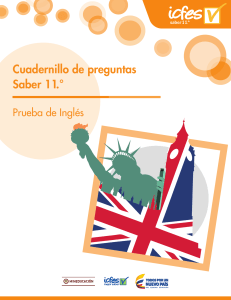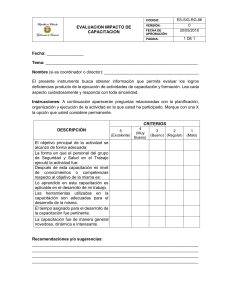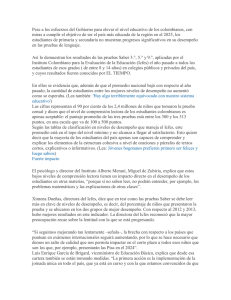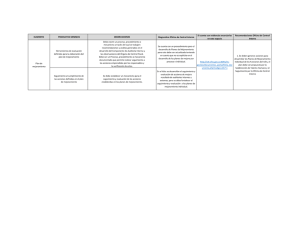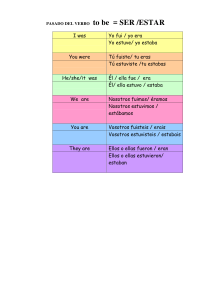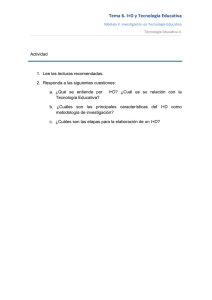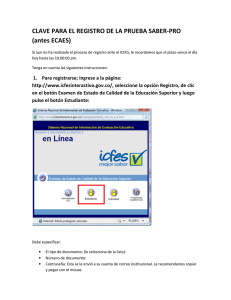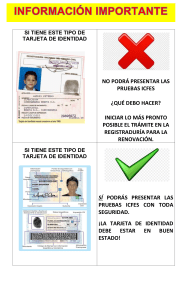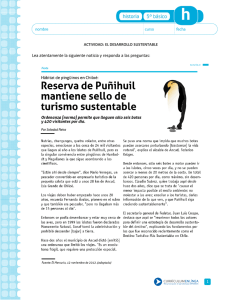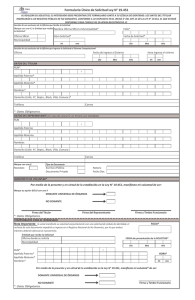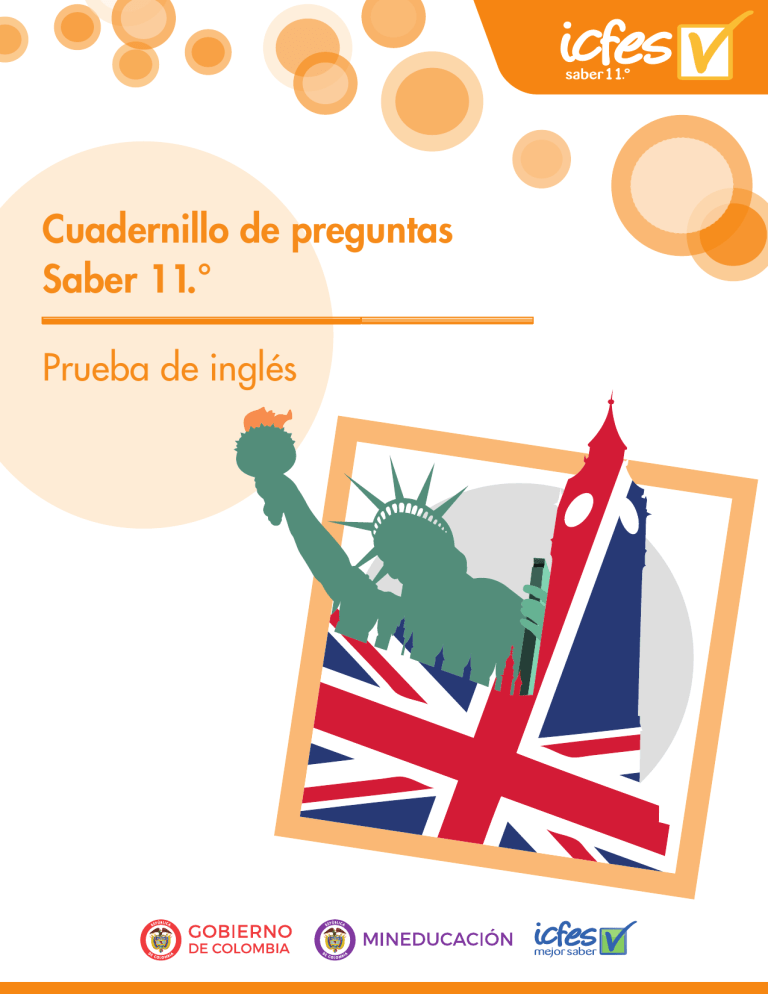
Cuadernillo de preguntas Saber 11.° Prueba de inglés Presidente de la República Iván Duque Márquez Ministra de Educación Nacional María Victoria Angulo González Viceministro de Educación Preescolar, Básica y Media Constanza Liliana Alarcón Párraga Directora General María Figueroa Cahnspeyer Secretaria General Liliam Amparo Cubillos Vargas Directora de Evaluación Natalia González Gómez Director de Producción y Operaciones Mateo Ramírez Villaneda Director de Tecnología Felipe Guzmán Ramírez Publicación del Instituto Colombiano para la Evaluación de la Educación (Icfes) © Icfes, 2018. Todos los derechos de autor reservados. María Paula Vernaza Díaz Luis Eduardo Jaramillo Flechas Gestores de la Prueba Moravia Elizabeth González Peláez Stephanie Puentes Valbuena Revisión de estilo William Frederick Juan Camilo Gómez Barrera Diagramación Diana Téllez Martínez Subdirectora de Producción de Instrumentos Nubia Rocío Sánchez Martínez Subdirector de Diseño de Instrumentos Luis Javier Toro Baquero Subdirector de Estadísticas Jorge Mario Carrasco Ortiz Subdirectora de Análisis y Divulgación Ana María Restrepo Sáenz ISSN de la versión digital: En trámite Bogotá, D. C., noviembre de 2018 ADVERTENCIA Todo el contenido es propiedad exclusiva y reservada del Icfes y es el resultado de investigaciones y obras protegidas por la legislación nacional e internacional. No se autoriza su reproducción, utilización ni explotación a ningún tercero. Solo se autoriza su uso para fines exclusivamente académicos. Esta información no podrá ser alterada, modificada o enmendada. TÉRMINOS Y CONDICIONES DE USO PARA PUBLICACIONES Y OBRAS DE PROPIEDAD DEL ICFES El Instituto Colombiano para la Evaluación de la Educación (Icfes) pone a la disposición de la comunidad educativa y del público en general, DE FORMA GRATUITA Y LIBRE DE CUALQUIER CARGO, un conjunto de publicaciones a través de su portal www.icfes.gov.co. Dichos materiales y documentos están normados por la presente política y están protegidos por derechos de propiedad intelectual y derechos de autor a favor del Icfes. Si tiene conocimiento de alguna utilización contraria a lo establecido en estas condiciones de uso, por favor infórmenos al correo prensaicfes@icfes.gov.co. Queda prohibido el uso o publicación total o parcial de este material con fines de lucro. Únicamente está autorizado su uso para fines académicos e investigativos. Ninguna persona, natural o jurídica, nacional o internacional, podrá vender, distribuir, alquilar, reproducir, transformar*,1 promocionar o realizar acción alguna de la cual se lucre directa o indirectamente con este material. Esta publicación cuenta con el registro ISBN (International Standard Book Number, o Número Normalizado Internacional para Libros) que facilita la identificación no solo de cada título, sino de la autoría, la edición, el editor y el país en donde se edita. En todo caso, cuando se haga uso parcial o total de los contenidos de esta publicación del Icfes, el usuario deberá consignar o hacer referencia a los créditos institucionales del Icfes respetando los derechos de cita; es decir, se podrán utilizar con los fines aquí previstos transcribiendo los pasajes necesarios, citando siempre al Icfes como fuente de autor. Lo anterior siempre que los pasajes no sean tantos y seguidos que razonadamente puedan considerarse como una reproducción simulada y sustancial, que redunde en perjuicio del Icfes. Asimismo, los logotipos institucionales son marcas registradas y de propiedad exclusiva del Icfes. Por tanto, los terceros no podrán usar las marcas de propiedad del Icfes con signos idénticos o similares respecto de cualesquiera productos o servicios prestados por esta entidad, cuando su uso pueda causar confusión. En todo caso queda prohibido su uso sin previa autorización expresa del Icfes. La infracción de estos derechos se perseguirá civil y, en su caso, penalmente, de acuerdo con las leyes nacionales y tratados internacionales aplicables. El Icfes realizará cambios o revisiones periódicas a los presentes términos de uso, y los actualizará en esta publicación. El Icfes adelantará las acciones legales pertinentes por cualquier violación a estas políticas y condiciones de uso. * La transformación es la modificación de la obra a través de la creación de adaptaciones, traducciones, compilaciones, actualizaciones, revisiones y, en general, cualquier modificación que de la obra se pueda realizar, de modo que la nueva obra resultante se constituya en una obra derivada protegida por el derecho de autor, con la única diferencia respecto de las obras originales de que aquellas requieren para su realización de la autorización expresa del autor o propietario para adaptar, traducir, compilar, etcétera. En este caso, el Icfes prohíbe la transformación de esta publicación. ¿Qué contiene este cuadernillo? Este es un cuadernillo con preguntas de la Prueba de inglés de Saber 11.° que fueron utilizadas en exámenes anteriores. Vas a poder acceder a 2 exámenes de ejemplo. Estas serán útiles para familiarizarte y conocer aún más la prueba. Al cada una de las preguntas. ¡Recuerda! Los exámenes Saber evalúan competencias, por tanto, en las preguntas encontrarás una situación (que debes tratar de entender) en la que tendrás que aplicar tus conocimientos para tomar decisiones y elegir la mejor respuesta. 4 PRUEBA DE INGLÉS Examen 1 PARTE 1 RESPONDA LA PREGUNTA 1 DE ACUERDO CON EL EJEMPLO ¿Dónde puede ver estos avisos? En la pregunta 1, marque A, B o C en su hoja de respuestas. Ejemplo: 0. 1. Please, put the books on the correct desk Draw a line to complete the snake and color it A. B. C. Respuesta: 0. A. B. C. in a school in a clothes shop in a toy store A B C on a rug on a test on a bookcase Prueba de Inglés 5 PARTE 2 RESPONDA LAS PREGUNTAS 2 A 6 DE ACUERDO CON EL EJEMPLO Lea las descripciones de la columna de la izquierda (2 - 6). ¿Cuál palabra de la columna de la derecha (A - H) concuerda con cada descripción? Una opción (A - H) se usa para el ejemplo. Sobran dos opciones más. En las preguntas 2 - 6, marque la letra correcta A - H en su hoja de respuestas. Clothes and accessories Ejemplo: 0. When you wear this, people can’t see your hair very well. Respuesta: 2. 3. 4. 5. 6. 6 0. A B C A woman carries her things in one of these. Many girls wear this when they don't want to wear trousers. D E F G A. pajamas B. glasses C. handbags D. hat E. scarf F. skirt G. socks H. watch With this, your neck won't be cold. When people can't see well, they need them. These are for your feet. H PARTE 3 RESPONDA LAS PREGUNTAS 7 Y 8 DE ACUERDO CON EL EJEMPLO Complete las cinco conversaciones. En las preguntas 7 - 8, marque A, B o C en su hoja de respuestas. Ejemplo: A. Just a minute. Can I use your printer? B. Do it this way. C. Think about it. Respuesta: 7. 8. Grandma, shall I hold those bags for you? How much is that umbrella? 0. A B C A. B. C. I'm not afraid! What's the matter? That's fine. A. B. C. Anything else? 50 dollars. Cash only! Prueba de Inglés 7 PARTE 4 RESPONDA LAS PREGUNTAS 9 A 16 DE ACUERDO CON EL SIGUIENTE TEXTO Lea el texto y seleccione la palabra correcta para cada espacio. En las preguntas 9 - 16, marque A, B o C en su hoja de respuestas. COFFEE Coffee is popular around the world. (0)_____ the past centuries, few subjects have been as carefully studied as coffee. Its (9)_____ important component is caffeine and it has lots of benefits. Coffee has been well-known (10)_____ the beginning of the 14 th century, (11)_____ Sufi Yemenis started using coffee to stay alert during special activities. It became a popular medicine (12)_____ Europeans in the 1600s. Caffeine was first (13)_____ in the 1800s by Ferdinand Runge, a doctor that found out some effects that coffee has on people. Some people say (14)_____ coffee isn’t good, but doctors say you (15)_____ believe this. Thanks to caffeine you don’t get hungry. Coffee can also reduce headaches and blood problems. (16)_____ many people believe coffee is bad, studies show it is good for your heart. Ejemplo: 0. A. Over B. C. By Across Respuesta: 8 9. A. much B. more C. most 10. A. during B. until C. since 11. A. when B. which C. who 12. A. among B. about C. along 13. A. describe B. described C. describes 14. A. drink B. drinking C. drunk 15. A. mustn’t B. couldn’t C. wouldn’t 16. A. while B. if C. because 0. A B C PARTE 5 RESPONDA LAS PREGUNTAS 17 A 23 DE ACUERDO CON EL SIGUIENTE TEXTO Lea el texto y responda las preguntas. En las preguntas 17 - 23, marque A, B o C en su hoja de respuestas. JAMES SALTER’S DAYS IN FILM James Salter was a pilot in the United States Air Force. He abandoned the military profession in 1957 after the publication of his first novel, The Hunters. He is best known as a novelist, but during the sixties and seventies, he worked in film making. Salter made documentaries, wrote texts for films, and even was the director of a film called Three, starring Charlotte Rampling and Sam Waterston. In Passionate Falsehoods, which was adapted from Salter’s book Burning the Days, published in The New Yorker in 1997, Salter tells the story of his life in film. Salter’s time in the film world is both good and bad. In Rome, he met directors and stars. In New York, he explored the city with Robert Redford and enjoyed being famous. Deborah Treisman and Michael Agger have talked about Salter. Nick Paumgarten in The Last Book, describes Salter’s opinion about his film career: “Of sixteen texts for movies, only four were popular. There was money, attractive women, and entrance into rooms where there were stories more for the dinner table than for the page.” Salter thought he was wasting his time. Perhaps he wasted his time in a larger artistic way, but it still makes for attractive reading. The Last Book is available to everyone in online stores. Prueba de Inglés 9 Ejemplo: 0. James Salter is famous for A. B. C. his books. his movies. his plays. Respuesta: 10 0. A 17. James Salter played an important part in the making of movies from A. B. C. 1960 to 1979. 1960 to 1970. 1960 to 1985. 18. Passionate Falsehoods is A. B. C. a newspaper. a play. a movie. 19. Salter had nice and difficult times in his A. B. C. acting years. big screen work. visit to one city. 20. The Last Book was written by A. B. C. James Salter. Deborah Treisman. Nick Paumgarten. 21. James Salter thinks that his work in the cinema business was A. B. C. not useful. not hard. not usual. 22. Reading about James Salter's years in the cinema could be A. B. C. clever enough. just fair. quite interesting. 23. The Last Book can be found A. B. C. in museums. at a café. on the web. B C PARTE 6 RESPONDA LAS PREGUNTAS 24 Y 25 DE ACUERDO CON EL SIGUIENTE TEXTO Lea el texto y responda las preguntas. En las preguntas 24 - 25, marque A, B, C o D en su hoja de respuestas. Swift Pizza and Sandwich House Today we have the pleasure of showing you the best letter written by our customer Mark. He wins £25 for writing about us this week. He is so happy with the orders at Swift Pizza and Sandwich House that he wants to declare a holiday to celebrate his experience here: “Happy burgerday and Merry Sandwichmas to everyone!” he wrote. Wednesday May 18, 2011. One typical day I was too tired after working all day long to cook for myself, and I was very hungry. I really wanted something to eat, so I decided to find a burger. I ordered a half-pound burger and a lamb and chicken sandwich. I also made some special orders for extra cheese and vegetables. Food arrived very fast (less than twenty minutes) and was hot and fresh. The burger was delicious, and left me wanting more - fortunately I had the sandwich left. It felt as if it had been cut just a minute before I opened it - juicy, fresh, and great. Every single special request I made was completely satisfied, 100%! And the best thing was that all of the above and some drinks cost me ONLY 10 dollars! If that doesn't say value for money, I don't know what does. It certainly feels great to find new excellent food delivery companies for whenever you don't feel like cooking yourself. I recently had a sad experience with my usual take away restaurant, so I decided to change to something else - and on my first try I got what I wanted! Order now from Swift Pizza and Sandwich House. Mark Prueba de Inglés 11 24. According to the text, the customer A. left a £25 tip to the waiters who work there. B. celebrated Christmas and New Year at this restaurant. C. found this great restaurant after many attempts. D. posted an excellent review about this restaurant. 25. It can be inferred from the text that Mark A. does not like cooking food for himself. B. almost always eats hamburgers. C. enjoys eating fast food sometimes. D. is tired of going to restaurants. 12 Examen 2 PARTE 1 RESPONDA LA PREGUNTA 1 A 3 DE ACUERDO CON EL EJEMPLO ¿Dónde puede ver estos avisos? En la preguntas 1 - 3, marque A, B o C en su hoja de respuestas. Ejemplo: A. B. C. 0. 0. Respuesta: 1. 2. 3. Please, take the one you want to read at a school on a street in a flat A B A. B. C. on a plane on a bus on a boat A. B. C. in a house in a shop in a zoo A. B. C. on a board on a computer on a bookcase C Prueba de Inglés 13 PARTE 2 RESPONDA LAS PREGUNTAS 4 A 6 DE ACUERDO CON EL EJEMPLO Lea las descripciones de la columna de la izquierda (4 - 6). ¿Cuál palabra de la columna de la derecha (A - H) concuerda con cada descripción? Una opción (A - H) se usa para el ejemplo. Sobran dos opciones más. En las preguntas 4 - 6, marque la letra correcta A - H en su hoja de respuestas. Transportation Ejemplo: 0. You often learn to ride it when you are a child. Respuesta: 4. 5. 6. 14 0. A People drive it on a road and it carries big things. People pay to take this public transport by road. B C D E F G H A. ambulance B. bike C. boat D. bus E. motorbike F. plane G. truck H. train Many people fly on it to go to a place. PARTE 3 RESPONDA LAS PREGUNTAS 7 A 9 DE ACUERDO CON EL EJEMPLO Complete las cinco conversaciones. En las preguntas 7 - 9, marque A, B o C en su hoja de respuestas. Ejemplo: A. I am sorry. I think I am getting sick. B. I can too. C. I need it. 0. Respuesta: A B C 7. I can’t eat a cold sandwich. It is horrible! A. B. C. I hope so. I agree. I am not. 8. I am going on vacation to Vancouver! A. B. C. That’s great! I like swimming! You are first! 9. It rained a lot last night! A. B. C. Did you accept? Did you understand? Did you sleep? Prueba de Inglés 15 PARTE 4 RESPONDA LAS PREGUNTAS 10 A 14 DE ACUERDO CON EL SIGUIENTE TEXTO Lea el texto y seleccione la palabra correcta para cada espacio. En las preguntas 10 - 14, marque A, B o C en su hoja de respuestas. Ejemplo: 0. A. which B. where C. who Respuesta: 16 10. A. saying B. said C. say 11. A. its B. his C. your 12. A. This B. That C. These 13. A. larger B. largest C. large 14. A. in B. along C. on 0. A B C PARTE 5 RESPONDA LAS PREGUNTAS 15 A 19 DE ACUERDO CON EL SIGUIENTE TEXTO Lea el texto y responda las preguntas. En las preguntas 15 - 19, marque A, B o C en su hoja de respuestas. Ejemplo: 0. When she was seven, she slept A. B. C. for some hours. very well. a lot. Respuesta: 0. 15. Where was the painter from? A. B. C. Ireland Spain France 16. She was mostly excited by the A. B. C. painter’s ability. painter’s voice. painter’s show. 17. How often did she watch the show? A. B. C. three times a week once a week twice a week 18. She could not get oil paints because she A. B. C. didn’t speak Spanish. was too young. always watched TV. 19. Stopping painting was A. B. C. the painter’s idea. her mother’s order. her own decision. A B C Prueba de Inglés 17 PARTE 6 RESPONDA LAS PREGUNTAS 20 Y 21 DE ACUERDO CON EL SIGUIENTE TEXTO Lea el texto y responda las preguntas. En las preguntas 20 - 21, marque A, B, C o D en su hoja de respuestas. - 18 20. What is the writer trying to do in this article? A. B. C. D. convince people to buy a Colombian coffee farm tell readers to run a coffee business in Colombia invite tourists to write about places they visit in Colombia encourage tourists to visit Colombia 21. What can a reader find out from this text? A. B. C. D. which activities tourists prefer to do at the farm when the best time is to visit the farm what the accommodation price includes how to grow coffee on the farm PARTE 7 RESPONDA LAS PREGUNTAS 22 A 25 DE ACUERDO CON EL SIGUIENTE TEXTO Lea el texto y seleccione la palabra correcta para cada espacio. En las preguntas 22 - 25, marque A, B, C o D en su hoja de respuestas. Ejemplo: 0. A. happens B. appears C. shows Respuesta: D. passes 0. A 22. A. where B. why C. when D. what 23. A. essays B. stories C. reports D. letters 24. A. off B. in C. at D. out 25. A. almost B. only C. hardly D. just B C Prueba de Inglés 19 Información de cada pregunta Examen 1 20 Examen 2 Posición Dificultad Respuesta correcta Posición Dificultad Respuesta correcta 1 Pre A1 B 1 Pre A1 B 2 Pre A1 C 2 Pre A1 B 3 A1 F 3 Pre A1 C 4 Pre A1 E 4 A1 G 5 A1 B 5 A1 D 6 Pre A1 G 6 A1 F 7 A1 C 7 A1 B 8 A1 B 8 A1 A 9 A1 C 9 A1 C 10 A2 C 10 A2 B 11 A1 A 11 A2 A 12 A2 A 12 A2 C 13 A1 B 13 A2 B 14 A1 B 14 A2 A 15 A2 A 15 A2 C 16 A2 A 16 A2 A 17 A2 A 17 A2 B 18 A2 C 18 A2 B 19 A2 B 19 A2 B 20 A2 C 20 B1 D 21 A2 A 21 B1 C 22 A2 C 22 B1 B 23 A2 C 23 B1 B 24 B1 D 24 B1 D 25 B1 C 25 B1 A Calle 26 N.° 69-76, Torre 2, Piso 15, Edificio Elemento, Bogotá, D. C., Colombia • www.icfes.gov.co Líneas de atención al usuario: Bogotá Tel.: (57+1) 484-1460 | PBX: (57+1) 484-1410 - Gratuita nacional: 018000-519535
